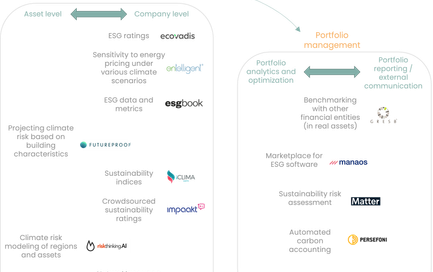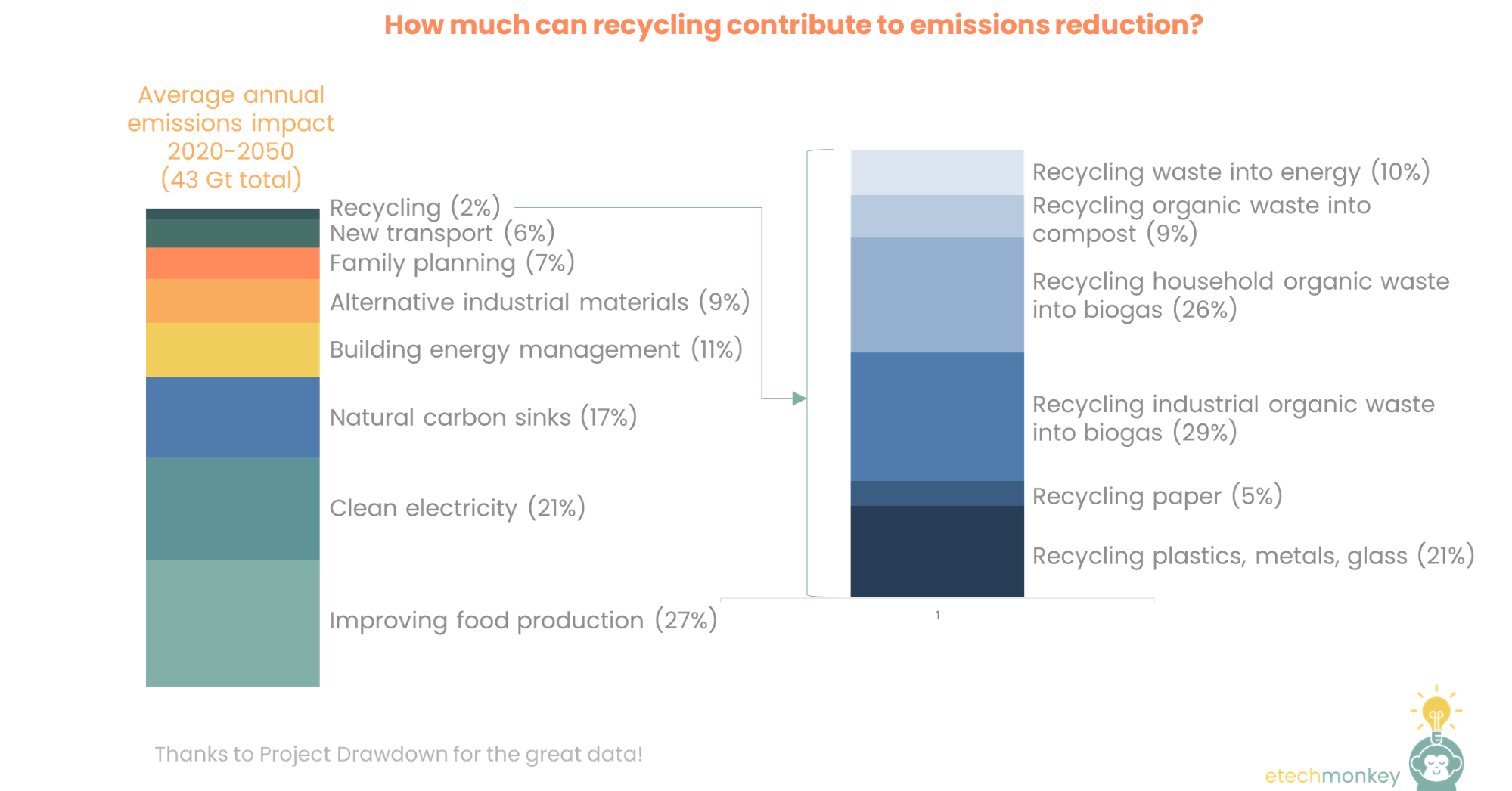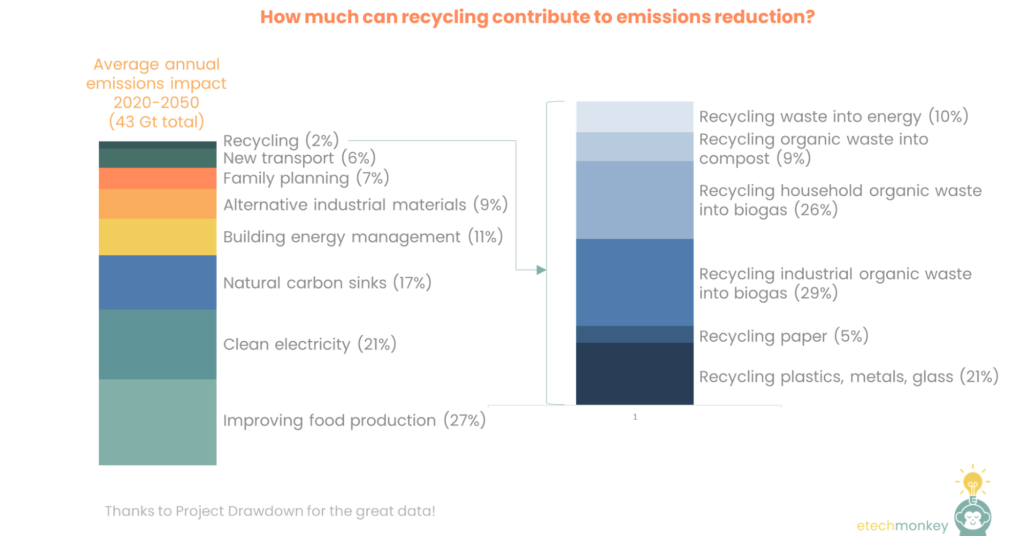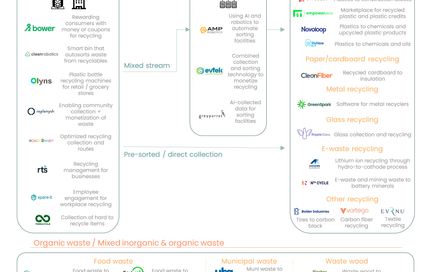
How recycling fits into climatetech (circular economy Pt 1)

Today I want to talk about…recycling!
Recycling is often more so described as “cleantech” instead of “climatetech” because the conversation typically revolves around its impact on surrounding ecology – less trash = less wildlife in danger = better for biodiversity. It’s not commonly talked about in the context of reducing emissions, and in fact, many in the climatetech universe consider recycling to be a potential distraction away from climate goals. Consider these headlines:
- How Useful is Recycling, Really? (Among all possible climate actions, recycling ranks pretty low in its impact.)
- Why Recycling Isn’t the Answer Part 3: Carbon Footprint
- A focus on waste: Is recycling a climate change solution or part of the problem?
But recycling does have a tangible and positive impact on emissions. It helps avoid both the process emissions from virgin materials (by sourcing those materials from recycled material) and the emissions from decomposition of landfill waste (by diverting landfill waste to recycling centers).
At the surface level, the quantity of this potential emissions reduction is small. Project Drawdown calculates ~0.2 Gt/year average impact (5.5-6 Gt over 30 years) assuming household and commercial recycling rates more than double to ~65-68% by 2050. But that estimate doesn’t cover potential impacts from recycling paper (~0.04 – 0.07 Gt/year), “recycling” organic waste like food scraps into compost (~0.07 – 0.1 Gt/year), digesting industrial scale organic waste from ag and wastewater into biogas (~0.2 – 0.3 Gt/year), digesting household organic waste into biogas for cooking (0.15 – 0.32 Gt/year), landfill gas capture (~0 – 0.07 Gt/year), and other waste-to-energy (~0.07 – 0.1 Gt/year), which all add up to about another 0.7 Gt/year impact. So all in all, the practice of recycling – in the broadest sense of the word – can reduce annual emissions by nearly 1 Gt.
And that’s only the direct impact of recycling to emissions. There are also indirect impacts which are harder to quantify.
- One indirect impact is the effect of recycling on land. The US, for example, is set to run out of landfills within 15 years unless new landfills are added or we increase waste incineration like Japan or the Nordic countries have (which traditionally is less carbon intensive than straight landfill disposal but without CCUS, does release emissions). An average landfill is 600 acres of land, enough for 80MW of solar or 20MW of wind. In order to add enough capacity to offset the current waste generation rate in the US of ~300 million tons a year, the industry needs to add up to 158 landfills (assuming 1,300 lbs waste/cubic yard, 121 thousand cubic yards/acre, 25-year lifespan / 600 acre landfill) or nearly 100,000 acres every year. That’s using new land roughly the size of the US Virgin Islands every year.
As land becomes a critical issue for deploying climate solutions, waste management firms will need to find new ways of disposing waste that doesn’t use land…and recycling can help with that. We likely underestimate the emissions impact that recycling can have via enabling land to be used for other climate solutions. - Recycling can catalyze other circular economy technologies. Circular economy includes the development of product lifecycles that are longer and better enable reuse and recycle. That includes new materials, new sources of materials, new services/technologies to help materials move from one stage of the circular economy to another, etc.
For materials developers, finding a new material that 1) has all of the properties needed for an application, 2) is sustainably sourced, and 3) can be sustainably disposed of is like threading a fine needle. Bringing to market new, better methods of recycling can at least help prevent #3 from being a bottleneck by offering new materials developers more options for closing the loop. In turn, those materials developers have a higher chance of scaling their product to displace more carbon intensive counterparts. An easy example of this is carbon fiber, which has enabled the scale up of wind blades. Companies that are working on recycling carbon fiber are also helping lower the carbon intensity of wind blades, keeping wind energy carbon competitive with other alternative energy solutions.
The potential emissions impact of new materials having an easier time scaling because of recycling options is hard to pin down but is again, likely underestimated. - Finally, recycling is the gateway drug to more fervent climate action. The nice thing about recycling is that it’s a daily activity for consumers and businesses to pay attention to. It keeps environmental consciousness at the forefront of topical issues, which helps keep climate at the forefront as well. Encouraging good recycling practices for a collective good is a parallel exercise to getting consumers and businesses to care about their carbon footprint for a collective good as well. It’s no surprise that most consumers that care about recycling also take on other low carbon lifestyle changes.
The point is recycling does have an impact on the climate and we should care about it for climate reasons in addition to the much-discussed ecological and “courteous neighbor” reasons. It’s not a solution set we should deprioritize because of its arms-length relationship with direct emissions. Recycling is firmly within climatetech.
Next week, I plan to chart out the different types of recycling (and related circular economy) technologies. Stay tuned!


